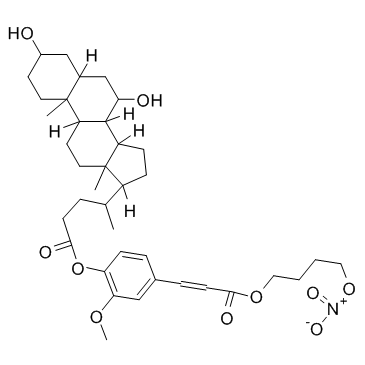401519-96-8
| Name | NCX 1000 |
|---|---|
| Synonyms |
Cholan-24-oic acid, 3,7-dihydroxy-, 2-methoxy-4-[(1E)-3-[4-(nitrooxy)butoxy]-3-oxo-1-propen-1-yl]phenyl ester, (3α,5β,7β,8ξ)-
2-Methoxy-4-{(1E)-3-[4-(nitrooxy)butoxy]-3-oxo-1-propen-1-yl}phenyl (3α,5β,7β,8ξ)-3,7-dihydroxycholan-24-oate |
| Description | NCX 1000 is a liver-specific NO donor compound derived from ursodeoxycholic acid (UDCA). |
|---|---|
| Related Catalog | |
| In Vivo | NCX-1000 (15 mg/kg, p.o.) prevents ascite formation, reduces collagen deposition in CCl4-treated rats. NCX-1000 administration almost completely reverts portal hypertension induced by CCl4, and reduces portal pressure in cirrhotic rats. NCX-1000 reverts HSC contraction induced by FCS, and also inhibits MCP-1 release from HSCs stimulated with TNF-α and IFN-γ[1]. NCX-1000 (28 mg/kg, p.o.) decreases portal pressure without affecting mean arterial pressure and heart rate in rats. NCX-1000 also reduces vasoconstriction by 60% caused by 30 μM NE in rats. Administration of NCX-1000 to BDL and sham operated rats results in a similar increase of nitrite/nitrate and cGMP concentrations in the liver[2]. |
| Animal Admin | Rats: On the first protocol, 54 rats, 12 animals/group unless specified, are randomly allocated to receive one of the following treatments: group 1 has phenobarbital induction and no further treatment; group 2 (16 animals) is treated with CCl4 twice a week for 8 weeks; group 3 has CCl4 twice a week plus UDCA (15 mg/kg); and group 4 has CCl4 twice a week plus NCX-1000 (15 mg/kg). NCX-1000 and UDCA are dissolved in carboxymethyl cellulose and administered daily by gavage. Animal weight is monitored daily through the study period, and the dosage of CCl4 is adjusted accordingly to the animal weight. At the end of the treatment surviving animals are killed by an overdose of uretane, and blood, ascitic fluid, and livers are collected. A portion of each liver is fixed in 10% formalin for histological evaluation. The remaining tissue is partitioned and immediately stored under frozen liquid nitrogen at -80°C until used. On the second protocol, 74 rats are randomly allocated to receive the same treatments as protocol 1. At the end of the study, surviving animals are tested for portal and arterial pressure measurement. |
| References |
| Density | 1.2±0.1 g/cm3 |
|---|---|
| Boiling Point | 758.3±60.0 °C at 760 mmHg |
| Molecular Formula | C38H55NO10 |
| Molecular Weight | 685.844 |
| Flash Point | 412.4±32.9 °C |
| Exact Mass | 685.382568 |
| LogP | 7.64 |
| Vapour Pressure | 0.0±2.7 mmHg at 25°C |
| Index of Refraction | 1.560 |
| Storage condition | 2-8℃ |
